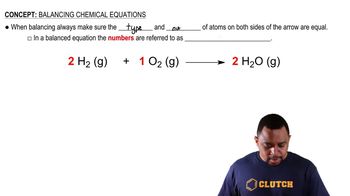The enthalpy of fusion of water is 6.01 kJ/mol. Sunlight striking Earth's surface supplies 168 W per square meter (1 W = 1 watt = 1 J/s). (b) The specific heat capacity of ice is 2.032 J/g°C. If the initial temperature of a 1.00 square emter patch of ice is -5.0°C, what is its final temperature after being in sunlight for 12 h, assuming no phase changes and assuming that sunlight penetration uniformly to a depth of 1.00 cm?
Ch.18 - Chemistry of the Environment
Chapter 18, Problem 44a
The Ogallala aquifer described in the Closer Look box in Section 18.3, provides 82% of the drinking water for the people who live in the region, although more than 75% of the water that is pumped from it is for irrigation. Irrigation withdrawals are approximately 18 billion gallons per day. (a) Assuming that 2% of the rainfall that falls on an area of 600,000 km2 recharges the aquifer, what average annual rainfall would be required to replace the water removed for irrigation?
 Verified step by step guidance
Verified step by step guidance1
Convert the daily irrigation withdrawal from gallons to cubic meters using the conversion factor: 1 gallon = 0.00378541 cubic meters.
Calculate the annual irrigation withdrawal by multiplying the daily withdrawal in cubic meters by the number of days in a year (365 days).
Determine the volume of water that needs to be recharged annually by dividing the annual irrigation withdrawal by the recharge percentage (2%).
Convert the area of 600,000 km^2 to square meters using the conversion factor: 1 km^2 = 1,000,000 m^2.
Calculate the average annual rainfall required by dividing the volume of water that needs to be recharged by the area in square meters. This will give the rainfall in meters, which can be converted to other units if needed.
Recommended similar problem, with video answer:

Verified Solution
This video solution was recommended by our tutors as helpful for the problem above
Video duration:
3mWas this helpful?
Key Concepts
Here are the essential concepts you must grasp in order to answer the question correctly.
Aquifer Recharge
Aquifer recharge refers to the process by which water from precipitation or surface water infiltrates into the ground and replenishes underground water reserves. In the context of the Ogallala aquifer, understanding how much rainfall contributes to this recharge is crucial for assessing the sustainability of water resources, especially when a significant portion is used for irrigation.
Recommended video:
Guided course

The Electrolytic Cell
Water Balance
Water balance is a hydrological concept that accounts for the inputs and outputs of water in a given system. It involves calculating the total amount of water entering (through precipitation and recharge) and leaving (through evaporation, transpiration, and withdrawals) the system. For the Ogallala aquifer, maintaining a positive water balance is essential to ensure that the aquifer can sustain its water supply for both drinking and irrigation.
Recommended video:
Guided course

Balancing Chemical Equations
Irrigation Water Use
Irrigation water use refers to the amount of water extracted from sources like aquifers for agricultural purposes. In the case of the Ogallala aquifer, understanding the scale of irrigation withdrawals (18 billion gallons per day) is vital for calculating the necessary rainfall to replenish the aquifer. This concept highlights the significant impact of agricultural practices on water resources and the need for effective management strategies.
Recommended video:
Guided course

Reaction with Water
Related Practice
Textbook Question
3702
views
Open Question
At the first-stage recovery of magnesium from seawater, the precipitation of Mg(OH)2 with CaO occurs in the following reaction: Mg2+(aq) + CaO(s) + H2O(l) → Mg(OH)2(s) + Ca2+(aq). What mass of CaO, in grams, is needed to precipitate 1000 lb of Mg(OH)2?
Open Question
Gold is found in seawater at very low levels, about 0.05 ppb by mass. Assuming that gold is worth about $1300 per troy ounce, how many liters of seawater would you have to process to obtain $1,000,000 worth of gold? Assume the density of water is 1.03 g/mL and that your gold recovery process is 50% efficient.
Textbook Question
The Ogallala aquifer described in the Closer Look box in Section 18.3, provides 82% of the drinking water for the people who live in the region, although more than 75% of the water that is pumped from it is for irrigation. Irrigation withdrawals are approximately 18 billion gallons per day. (b) What process or processes accounts for the presence of arsenic in well water?
356
views
Open Question
Assume that a portable reverse-osmosis apparatus operates on seawater, whose concentrations of constituent ions are listed in Table 18.5, and that the desalinated water output has an effective molarity of about 0.02 M. What minimum pressure must be applied by hand pumping at 297 K to cause reverse osmosis to occur? (Hint: Refer to Section 13.5.)
Open Question
List the common products formed when an organic material containing the elements carbon, hydrogen, oxygen, sulfur, and nitrogen decomposes (a) under aerobic conditions, (b) under anaerobic conditions.
